Don't wanna be here? Send us removal request.
Text
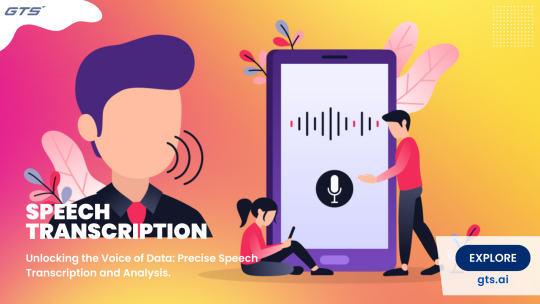
Audio datasets are often used for tasks such as speech recognition, speaker identification, music classification, and audio event detection. They may also include associated metadata, such as the language spoken, the gender and age of the speaker, the genre of the music, and the location and time of the recording visit our website: https://gts.ai/services/speech-data-collection/
0 notes
Text
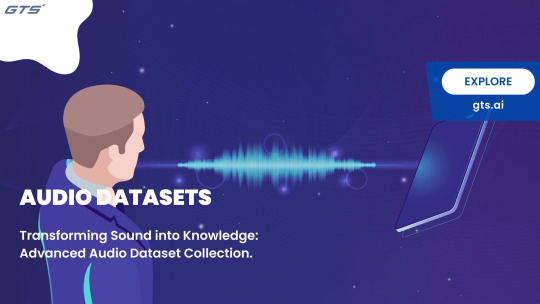
Audio datasets are often used for tasks such as speech recognition, speaker identification, music classification, and audio event detection. They may also include associated metadata, such as the language spoken, the gender and age of the speaker, the genre of the music, and the location and time of the recording visit our website:
0 notes
Text
From Soundwaves to Insights: Unleashing the Potential of Audio Datasets in AI
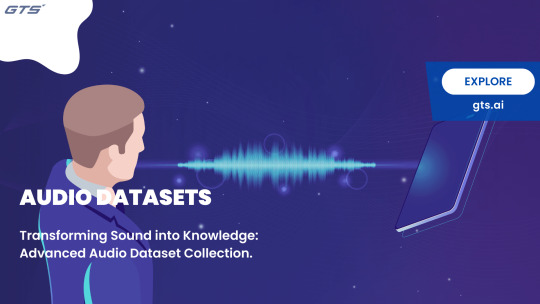
Introduction
Audio datasets has become an increasingly valuable resource in the field of artificial intelligence (AI). The ability to analyse and extract meaningful insights from soundwaves opens up a wide range of applications, including speech recognition, music analysis, acoustic event detection, and environmental monitoring. However, harnessing the full potential of audio datasets in AI requires overcoming several challenges, such as data collection, annotation, and preprocessing. In this article, we delve into the world of audio datasets, exploring their significance, the techniques used for their creation, and the ways in which they can be leveraged to drive innovation in AI.
The Importance of Audio Datasets in AI
1.The Power of Sound: This section highlights the unique value of audio data in AI applications. It explores how sound carries valuable information that complements other types of data, such as text and images. We discuss the advantages of audio data in capturing nuances of human communication, emotion, and environmental context. Furthermore, we explore the role of audio datasets in advancing speech recognition, audio classification, and sound source separation tasks, showcasing their potential impact in various domains.
2. Challenges in Audio Data Collection: Collecting high-quality audio datasets poses several challenges. This subheading focuses on the intricacies of audio data collection, including considerations such as recording equipment, environmental conditions, and ethical considerations. We discuss techniques for capturing diverse audio sources, such as microphones, acoustic sensors, and even smartphones. Additionally, we address the need for large-scale and diverse datasets to ensure robust AI models capable of generalising to real-world scenarios.
Preprocessing and Annotation of Audio Datasets
1. Audio Preprocessing: Audio data often requires preprocessing to enhance its quality and extract meaningful features. This section explores techniques such as noise reduction, signal normalisation, and audio segmentation to prepare audio datasets for AI applications. We discuss the challenges of handling background noise, reverberation, and varying recording conditions. Additionally, we explore the role of feature extraction methods, such as spectrograms and mel-frequency cepstral coefficients (MFCCs), in representing audio data effectively for subsequent analysis and modelling.
2.Annotation and Labelling: Annotating audio datasets with relevant labels and metadata is essential for supervised learning and model training. This subheading delves into the various methods used for audio annotation, including manual labelling, automatic speech recognition, and crowd-sourcing. We discuss the challenges of annotating audio data, such as dealing with multiple speakers, overlapping speech, and complex audio events. Furthermore, we explore the potential of weakly supervised and semi-supervised approaches in alleviating the annotation burden while maintaining dataset quality.
Conclusion:
In conclusion, audio datasets hold immense potential in driving innovation and advancement in AI. This article has shed light on the importance of audio data, exploring its unique value and the challenges associated with collecting, preprocessing, and annotating audio datasets.
As audio data continues to play a vital role in AI, it is crucial to invest in further research and development to overcome challenges and ensure the availability of high-quality, diverse, and well-annotated audio datasets. By doing so, we can unleash the true potential of soundwaves and pave the way for exciting advancements in AI-driven audio analysis and understanding.
0 notes
Text
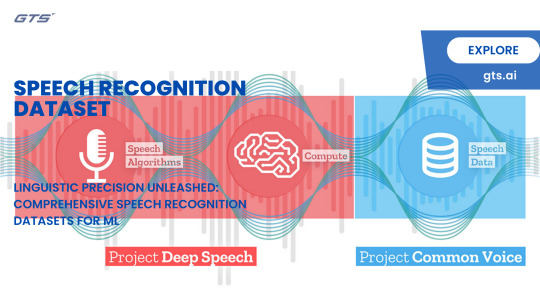
At a fraction of the expense and effort, automatic audio transcription has achieved near-human accuracy levels. However, if you want to improve the accuracy of automatic voice recognition, you’ll still need the assistance of real-life human transcribers. On the surface, audio transcription appears to be a simple task: write down what was said in an audio recording.
0 notes
Text
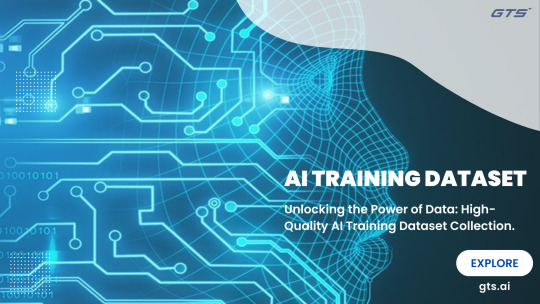
AI training datasets is a comprehensive and curated collection of structured and/or unstructured data specifically designed for machine learning (ML) purposes. It serves as a vital resource for training, validating, and testing ML algorithms and models
0 notes
Text
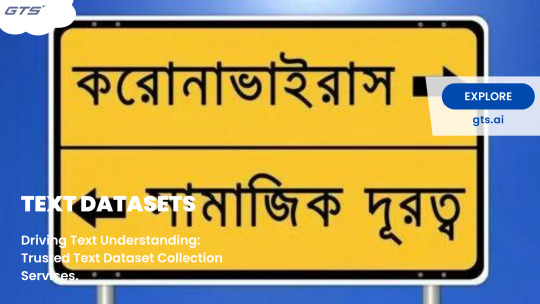
A text dataset is a collection of textual data that is used for various purposes, such as training machine learning models, conducting natural language processing (NLP) tasks, or analyzing text data. Text datasets can include a wide range of text types, such as books, articles, social media posts, emails, customer reviews, and more
0 notes
Text
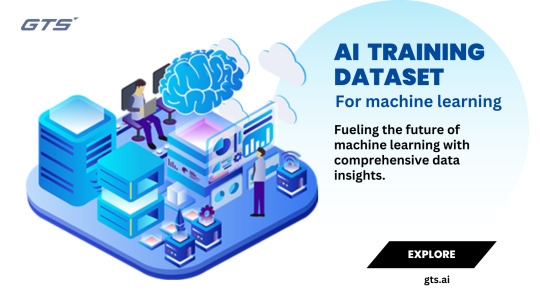
AI training datasets is a comprehensive and curated collection of structured and/or unstructured data specifically designed for machine learning (ML) purposes. It serves as a vital resource for training, validating, and testing ML algorithms and models
0 notes
Text
Unlocking the Power of AI: Demystifying the Importance of Training Datasets
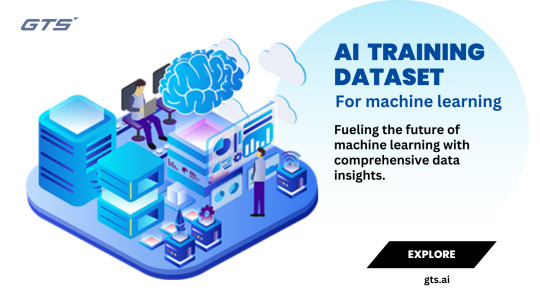
Introduction:
Artificial Intelligence (AI) has rapidly emerged as a transformative technology that is revolutionizing various industries. From healthcare to finance, transportation to entertainment, AI is reshaping the way we live and work. At the heart of this remarkable technology lies the concept of training datasets. In this blog, we will delve into the importance of AI training datasets and how they unlock the true potential of AI.
What are Training Datasets?
In simple terms, training datasets are a collection of data points used to train an AI model. These datasets contain examples, labeled or unlabeled, that enable AI algorithms to learn patterns, make predictions, and perform tasks. The quality, size, and diversity of the training dataset have a significant impact on the AI model’s performance.
The Role of Training Datasets in AI Development
Learning and Generalization: Training datasets serve as the foundation for AI models to learn and generalize. By exposing AI algorithms to a wide range of examples, the models can identify patterns, correlations, and trends within the data. This learning process enables AI models to make accurate predictions and perform complex tasks with new, unseen data.
Bias Mitigation: Training datasets play a crucial role in mitigating biases in AI systems. Biases can inadvertently be introduced into AI models if the training dataset is unrepresentative or contains skewed data. Therefore, it is essential to curate diverse and inclusive training datasets to ensure fairness and prevent AI systems from perpetuating discrimination or inequality.
Performance and Accuracy: The quality and size of the training dataset directly impact the performance and accuracy of AI models. A comprehensive and extensive dataset allows the AI model to capture a broader range of scenarios, leading to improved performance in real-world applications. Additionally, high-quality datasets help reduce errors and increase the reliability of AI predictions and decisions.
Adaptability and Robustness: Training datasets enable AI models to adapt and remain robust in dynamic environments. By exposing the models to diverse datasets, they can learn to handle variations, anomalies, and edge cases effectively. This adaptability is crucial for AI systems to perform well in real-world scenarios with unpredictable and changing conditions.
Challenges and Considerations
While training datasets are fundamental for AI development, there are several challenges and considerations to keep in mind:
Data Quality: Ensuring the quality and reliability of the training dataset is paramount. Noisy or inaccurate data can lead to misleading AI predictions or decisions. Data cleaning, preprocessing, and validation are essential steps to maintain dataset integrity.
Data Bias: Biases present in the training dataset can be inadvertently learned by AI models, leading to biased outcomes. Mitigating bias requires careful dataset curation, diverse representation, and ongoing monitoring of AI performance to detect and address any biases that emerge.
Data Privacy and Security: Training datasets often contain sensitive information, raising concerns about privacy and security. It is crucial to handle data responsibly, adhere to privacy regulations, and implement robust security measures to protect against unauthorized access or misuse.
How GTS can help you?
Global Technology Solutions is a AI based Data Collection and Data Annotation Company understands the need of having high-quality, precise datasets to train, test, and validate your models. As a result, we deliver 100% accurate and quality tested datasets. Image datasets, Speech datasets, Text datasets, ADAS annotation and Video datasets are among the datasets we offer. We offer services in over 200 languages.
0 notes
Text
The image data you have to be annotated before it is utilized. The practice of the process of labelling your dataset is known in the field of data annotation company. You can label your data on your own or use a third-party annotation service, or use the machine-learning automation. Even with machine learning visit here: https://gts.ai/image-and-video-annotation/
0 notes
Text
A text dataset is a collection of textual data that is used for various purposes, such as training machine learning models, conducting natural language processing (NLP) tasks, or analyzing text data. Text datasets can include a wide range of text types, such as books, articles, social media posts, emails, customer reviews, and more visit our website:
0 notes
Text
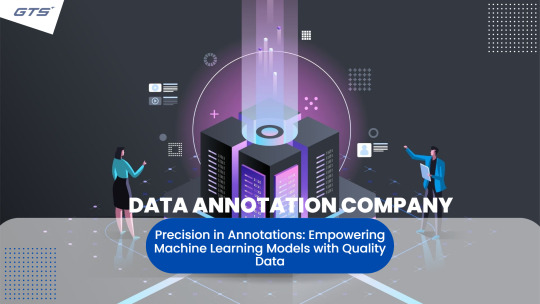
The image data you have to be annotated before it is utilized. The practice of the process of labelling your dataset is known in the field of data annotation company. You can label your data on your own or use a third-party annotation service, or use the machine-learning automation. Even with machine learning visit here: https://gts.ai/image-and-video-annotation/
0 notes
Text
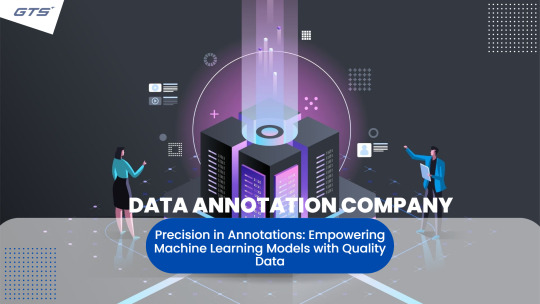
The image data you have to be annotated before it is utilized. The practice of the process of labelling your dataset is known in the field of data annotation company. You can label your data on your own or use a third-party annotation service, or use the machine-learning automation. Even with machine learning visit here: https://gts.ai/image-and-video-annotation/
0 notes
Text

ML Dataset" is a comprehensive and curated collection of structured and/or unstructured data specifically designed for machine learning (ML) purposes. It serves as a vital resource for training, validating, and testing ML algorithms and models
0 notes
Text
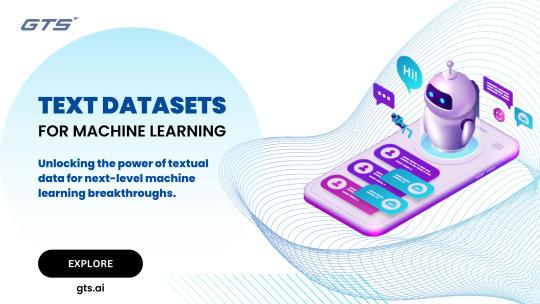
A text dataset is a collection of textual data that is used for various purposes, such as training machine learning models, conducting natural language processing (NLP) tasks, or analyzing text data. Text datasets can include a wide range of text types, such as books, articles, social media posts, emails, customer reviews, and more visit our website: https://gts.ai/services/text-data-collection/
0 notes
Text
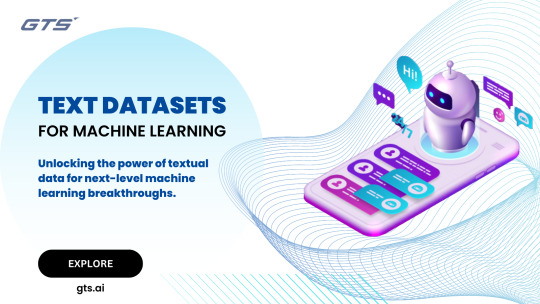
A text dataset is a collection of textual data that is used for various purposes, such as training machine learning models, conducting natural language processing (NLP) tasks, or analyzing text data. Text datasets can include a wide range of text types, such as books, articles, social media posts, emails, customer reviews, and more visit our website: https://gts.ai/services/text-data-collection/
0 notes
Text

The image data you have to be annotated before it is utilized. The practice of the process of labelling your dataset is known in the field of data annotation company. You can label your data on your own or use a third-party annotation service, or use the machine-learning automation. Even with machine learning visit here: https://gts.ai/image-and-video-annotation/
0 notes
Text
Elevate Your AI Vision: Unveiling the Power of Image Annotation Services

Introduction:
Image annotation services play a pivotal role in unlocking the full potential of artificial intelligence (AI) in various domains. By providing labeled data to train machine learning algorithms, these services enable AI systems to accurately understand and interpret visual content, revolutionizing industries such as autonomous vehicles, healthcare, e-commerce, agriculture, and more. In this article, we will delve into the power of image annotation services and how they elevate AI vision. What are the image annotation services
Image annotation services involve the process of labeling or annotating various objects or regions within an image. These services are often used to create training data for machine learning models that rely on visual recognition or understanding.
Here are some common types of image annotation services:
Bounding Box Annotation: This involves drawing rectangles or bounding boxes around objects of interest within an image. The bounding boxes indicate the location and size of the objects.
Semantic Segmentation: In this annotation method, each pixel of an image is labeled with a specific class. It enables precise object segmentation and identification.
Instance Segmentation: Similar to semantic segmentation, instance segmentation involves labeling each pixel with a specific class. However, it also differentiates individual instances of the same class, allowing for better object separation.
Polygon Annotation: Instead of using bounding boxes, this method involves drawing polygons around objects in an image. It provides more accurate and detailed annotations for irregularly shaped objects.
Landmark Annotation: Landmark annotation is used to mark specific points of interest within an image. It is commonly used for facial recognition or analysis tasks, where facial landmarks such as eyes, nose, and mouth are labeled.
Image Classification: This involves categorizing images into different classes or categories. Annotators assign appropriate labels to each image based on its content.
Text Annotation: This type of annotation focuses on annotating text or characters within an image. It is often used for tasks such as optical character recognition (OCR) or document analysis.3D Annotation: In certain cases, annotation is performed in a three-dimensional space. This is common in the annotation of point clouds, where objects are labeled based on their 3D coordinates.
These annotation services are typically offered by specialized companies or data labeling platforms that employ annotators to perform the task manually. The annotations produced through these services are crucial for training and evaluating machine learning models for computer vision tasks.
Best Practices for Effective Image Annotation
Clear Guidelines: Provide clear and detailed annotation guidelines to annotators. Clearly define the annotation tasks, labeling criteria, and any specific instructions or conventions to follow.
Quality Control: Implement a robust quality control process to ensure the accuracy and consistency of annotations. This may involve regular reviews, feedback loops, and inter-annotator agreement checks.
Training and Familiarization: Train annotators thoroughly on the annotation tasks, labeling conventions, and any specific tools or software used. Familiarize them with the domain or industry-specific knowledge relevant to the annotations.
Iterative Feedback: Maintain an open and constructive feedback loop with annotators. Regularly communicate with them, address their questions, provide clarifications, and share feedback on their work to improve the annotation quality.
Clear Labeling Conventions: Define clear and consistent labeling conventions to ensure uniformity in annotations. Use standardized class labels, colors, or annotation shapes to maintain clarity and facilitate automation in downstream processes.
Consider Edge Cases: Clearly define how to handle ambiguous or challenging cases. Provide guidelines or specific instructions for annotators to handle cases where objects are partially occluded, have low visibility, or exhibit variations in appearance.
Scalability and Efficiency: Optimize the annotation process for scalability and efficiency. Leverage tools, automation, and workflows that streamline the annotation process without compromising on accuracy.
Regular Updates: Keep annotation guidelines up to date with evolving requirements or changes in the project. Provide timely updates to annotators to ensure they are aware of any modifications or refinements in the annotation criteria.
Communication and Collaboration: Foster effective communication and collaboration among annotators, project managers, and domain experts. Encourage discussions, knowledge sharing, and addressing any ambiguities or challenges collectively.
Data Security and Privacy: Implement strict data security measures to protect the privacy and confidentiality of the annotated images. Ensure compliance with relevant data protection regulations and industry best practices.
Continuous Learning: Encourage annotators to learn from each other's expertise and share best practices. Provide opportunities for ongoing training, knowledge sharing sessions, and staying updated with the latest advancements in image annotation.By following these best practices, you can enhance the accuracy, consistency, and efficiency of image annotation, leading to high-quality training data for your AI vision.
Conclusion:
Data annotation company hold immense power in advancing AI capabilities and enabling organizations to unlock new opportunities. By leveraging high-quality annotated data, businesses can train AI models to understand and analyze visual content accurately. The applications are vast, ranging from healthcare to autonomous vehicles and beyond. Choosing a reliable image annotation provider and following best practices ensures optimal results and paves the way for continued success in your AI endeavors. Elevate your AI vision today by embracing the power of image annotation services.
0 notes